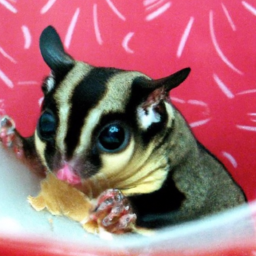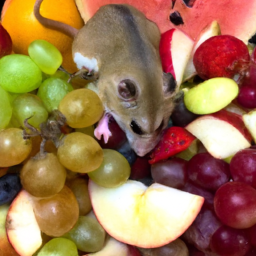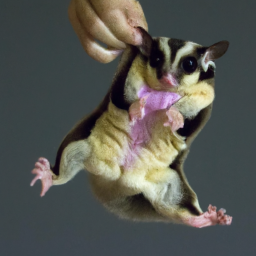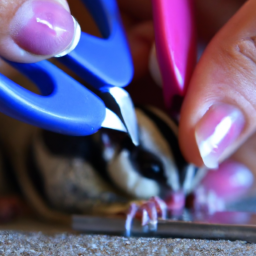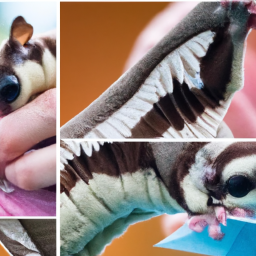How To Potty Train A Sugar Glider
So you want to learn how to potty train a sugar glider? Well, you’ve come to the right place! In this article, we’ll guide you through the steps of training your adorable little glider to use a designated potty area. It may sound like a daunting task, but with a little patience and consistency, you’ll be surprised at how quickly your sugar glider can learn this important skill. Get ready to say goodbye to those messy accidents!
Are you curious about the secrets behind successful sugar glider potty training? In this article, we’ll delve into the specifics and provide you with all the information you need to get started. We’ll take you through the initial steps of setting up a potty area in your glider’s cage, explain how to introduce your pet to the concept of using the potty, and offer tips for troubleshooting any challenges you might encounter along the way. So sit tight and get ready to become a pro at teaching your sugar glider this essential skill. Your clean and tidy home will thank you!
Understanding Sugar Gliders
Introduction to Sugar Gliders
Sugar gliders are small, adorable marsupials native to Australia and New Guinea. They are known for their unique ability to glide through the air using a flap of skin called a patagium. These nocturnal creatures make wonderful pets for individuals who are willing to put in the time and effort to properly care for them. One crucial aspect of caring for a sugar glider is potty training.
Behavior and Habits of Sugar Gliders
Before diving into potty training, it’s important to understand the behavior and habits of sugar gliders. These tiny creatures are naturally clean animals and will instinctively choose a specific area in their enclosure to relieve themselves. By taking advantage of this natural behavior, we can help train them to use a designated potty area.
Sugar gliders are highly social animals that thrive on interaction and bonding with their owners. Building a trusting and positive relationship with your sugar glider is essential for successful potty training. Understanding their body language and vocalizations can also help in establishing effective communication during the training process.
Why Potty Training is Important for Sugar Gliders
Potty training is an important aspect of sugar glider care for several reasons. Firstly, it helps to maintain a clean and hygienic environment for both you and your pet. Sugar gliders are prone to certain health issues, and regular cleaning of their enclosure can minimize the risk of infections and illnesses.
Secondly, potty training allows for easier maintenance and cleaning of the enclosure. By teaching your sugar glider to use a specific area for elimination, you can easily spot-clean that area and avoid having to clean the entire enclosure frequently.
Lastly, potty training promotes a harmonious living environment. Your sugar glider will enjoy the freedom of their cage without soiling their play space, and you can enjoy a cleaner and more pleasant living area.
Preparing for Potty Training
Creating a Suitable Enclosure
Before embarking on potty training, it’s essential to provide your sugar glider with a suitable enclosure. An appropriate cage should be spacious enough to allow for natural behaviors such as climbing and gliding. It should also have multiple levels or branches to accommodate their love for climbing and jumping.
When it comes to potty training, it’s important to create a designated potty area within the enclosure. This area should be easily accessible to your pet and located away from their sleeping and eating areas. Use a shallow tray or corner litter box filled with safe and absorbent bedding material.
Choosing the Right Potty Training Products
Choosing the right potty training products is crucial for successful training. Opt for bedding materials that are safe for your sugar glider, such as shredded paper or aspen shavings. Avoid using materials that can be harmful if ingested, such as cedar or pine shavings.
Additionally, consider using a litter box with a low entry point to ease your sugar glider’s access. It’s important to choose a litter box that is easy to clean and won’t retain odor.
Establishing a Routine for Training Sessions
Establishing a routine for potty training sessions will help your sugar glider understand and adapt to the training process more easily. Consistency is key when it comes to training, so try to set aside specific times each day for training sessions.
During these sessions, allow your sugar glider to explore and play in a controlled area outside their cage. This will help them associate the training sessions with the specific potty area. Remember, sugar gliders have a short attention span, so keep the training sessions short and engaging.
Building Trust with Your Sugar Glider
Bonding Exercises with Your Sugar Glider
Building a strong bond with your sugar glider is essential before starting potty training. Spend quality time with your pet through gentle handling and bonding exercises. This can include activities such as carrying them in a bonding pouch, offering treats, and engaging in interactive play sessions.
Bonding exercises not only strengthen your connection but also help your sugar glider feel safe and secure in their environment. This trust and familiarity will make the potty training process smoother and more successful.
Developing a Positive Relationship
Positive reinforcement plays a significant role in building a positive relationship with your sugar glider. Rewarding desired behaviors with treats, praises, or favorite toys will help them associate the potty training process with positive experiences.
Avoid punishment or negative reinforcement, as this can cause stress and hinder the training process. Remember, sugar gliders respond best to gentle and patient guidance.
Understanding Your Sugar Glider’s Body Language
Understanding your sugar glider’s body language will greatly assist in effective communication during training. Sugar gliders express their emotions and needs through various signals, such as vocalizations, facial expressions, body postures, and tail movements.
For example, a sugar glider may flick its tail or emit a low growling sound when feeling threatened or anxious. Recognizing these signs will help you adjust your training approach and ensure your sugar glider feels comfortable and safe during the training process.
Introducing the Potty Training Process
Gradual Introduction to the Designated Potty Area
Once you have established trust and a routine, it’s time to introduce your sugar glider to the designated potty area. Place your glider in the area before and after meals, playtime, and sleeping sessions, as these are the times when they are most likely to need to eliminate.
It’s important to note that accidents may happen during this process, especially in the beginning. Stay patient and continue to encourage your sugar glider to use the designated potty area.
Using Positive Reinforcement During Training
Positive reinforcement is a key element of potty training your sugar glider. Each time your glider successfully eliminates in the designated potty area, provide immediate praise, treats, or a favorite toy. This positive association will encourage your pet to repeat the behavior in the future.
Avoid scolding or punishing your sugar glider for accidents outside the designated potty area. Instead, redirect them gently to the potty area and reward them when they use it correctly.
Teaching Your Sugar Glider to Recognize the Potty Command
As your sugar glider becomes more familiar with the potty training process, you can introduce verbal commands to associate with elimination. Use a simple word or phrase such as “go potty” or “use the potty” consistently while they are in the designated area. Over time, they will start to associate the command with the act of elimination.
Establishing a Potty Training Routine
Consistency and Patience in Training
Consistency and patience are key when it comes to potty training your sugar glider. Stick to the established routine and continue to reinforce positive behaviors. It’s important to remember that each sugar glider is unique, and training progress may vary.
Stay patient and avoid getting discouraged if accidents occur. Consistent reinforcement and gentle guidance will eventually lead to success.
Timing the Training Sessions
Timing is crucial during potty training sessions. Sugar gliders have a small bladder and may need to eliminate frequently. Ensure that you give your sugar glider ample opportunities to use the designated potty area, especially during active play sessions and after meals.
Be observant of their body language and, if necessary, interrupt their activities to guide them to the potty area. Remember, prevention is better than cleaning up accidents!
Creating a Reward System for Successful Potty Moments
Creating a reward system for successful potty moments can help reinforce the desired behavior. Keep a small container of treats handy during training sessions, and reward your sugar glider immediately after they eliminate in the designated area.
Choose treats that are safe and healthy for your pet, such as small pieces of fruits or vegetables, or specially formulated sugar glider treats. Use these rewards consistently to motivate and encourage your sugar glider.
Dealing with Accidents and Setbacks
Common Challenges During Potty Training
Potty training sugar gliders may come with a few challenges and setbacks. Some common issues include reluctance to use the designated potty area, accidents outside the enclosure, or inconsistent elimination patterns.
If you encounter these challenges, remain patient and adjust your training approach accordingly. Consistency, positive reinforcement, and reassessment of the training routine can help overcome these obstacles.
Effective Cleaning Methods for Accidents
Accidents are bound to happen during the potty training process. To effectively clean up after accidents, start by removing any solid waste using gloves or a scoop. Use a pet-safe disinfectant and thoroughly clean the affected area to eliminate any odor.
Avoid using harsh chemicals or products that may be toxic to your sugar glider. Opt for mild and gentle cleaning solutions specifically formulated for pet use.
Troubleshooting Training Difficulties
If you are experiencing persistent difficulties in potty training your sugar glider, it may be helpful to consult an exotic pet professional or veterinarian for guidance. They can provide additional advice and tips specific to your sugar glider’s needs.
Remember, each sugar glider is unique, and some may require more time and patience than others. Keep an open mind and be willing to adapt your training approach based on your pet’s individual needs.
Maintaining a Clean and Healthy Environment
Regular Cleaning of the Enclosure
Maintaining a clean and hygienic environment is crucial for the overall health and wellbeing of your sugar glider. Regularly clean the entire enclosure, including toys, perches, and feeding dishes, to prevent the buildup of bacteria or parasites.
Spot-clean the designated potty area daily, removing any soiled bedding and replacing it with fresh material. This will help establish and reinforce the habit of using the potty area consistently.
Choosing Appropriate Bedding Materials
Using safe and appropriate bedding materials is vital for your sugar glider’s health. Opt for bedding options such as shredded paper, aspen shavings, or specialized sugar glider bedding. Avoid materials that are dusty, too fibrous, or potentially harmful if ingested.
Monitor your sugar glider for any signs of allergies or respiratory issues. If these symptoms arise, consider changing the bedding material or seek advice from a veterinarian.
Monitoring Your Sugar Glider’s Overall Health
Potty training goes hand in hand with maintaining your sugar glider’s overall health. Regularly monitor your pet for any signs of illness or discomfort. Keep an eye out for changes in appetite, behavior, or bathroom habits.
Routine veterinary check-ups are essential to ensure the health and wellbeing of your sugar glider. Discuss any concerns or questions regarding potty training and general care during these visits.
Progress Evaluation and Adjustments
Assessing the Progress of Potty Training
Regularly assess the progress of your sugar glider’s potty training efforts. Keep track of successful elimination in the designated area, as well as any incidents outside the potty area.
Evaluate any patterns or trends that may emerge. This evaluation will help you determine if any adjustments or modifications to the training routine are necessary.
Modifying the Training Approach if Needed
It’s important to be flexible and adaptable when it comes to potty training your sugar glider. If you notice that your current training approach is not yielding the desired results, consider modifying your approach or seeking alternative training methods.
Every sugar glider is unique, and what works for one individual may not work for another. Explore different techniques and approaches until you find the one that suits your sugar glider’s personality and needs.
Seeking Professional Advice if Necessary
If you’re struggling to potty train your sugar glider or encounter persistent difficulties, don’t hesitate to seek professional advice. Contact a veterinarian experienced in exotic pet care or an exotic pet trainer for guidance and assistance.
These professionals can provide specific suggestions and solutions tailored to your sugar glider’s needs. They can also offer reassurance and support throughout the training process.
Tips for Successful Potty Training
Using Positive Reinforcement Techniques
Positive reinforcement is a powerful tool in potty training your sugar glider. Reward desired behaviors consistently and immediately after they occur. This positive association will motivate your pet to repeat the behavior in the future.
Avoid punishment or negative reinforcement, as it can cause stress and hinder the training progress. Stay patient, encouraging, and supportive throughout the training process.
Keeping Training Sessions Fun and Engaging
Make potty training sessions fun and engaging for your sugar glider. Use interactive toys, treats, and playtime to create a positive association with the training process. Incorporate games, challenges, and social interaction to keep your pet interested and motivated.
Remember, sugar gliders have a short attention span, so keep the training sessions short and focused. End each session on a positive note to leave your sugar glider excited for the next session.
Being Patient and Understanding with Your Sugar Glider
Potty training takes time and patience. It’s important to remain calm, patient, and understanding throughout the training process. Accidents will happen, setbacks may occur, and progress may be slow at times.
Remember that your sugar glider is trying its best to learn and adapt to the training routine. Celebrate every small achievement and maintain a positive attitude to create a supportive and nurturing environment for your pet.
Can Potty Training Techniques be Used to Train a Sugar Glider to Come to You?
Yes, you can train your sugar glider to come to you using potty training techniques. Consistency and positive reinforcement are key. Use a designated area for treats and be patient. With time and practice, your sugar glider will learn to come when called.
Conclusion
Potty training a sugar glider is an essential aspect of their care and wellbeing. By understanding their behavior, establishing a routine, building trust, and using positive reinforcement, you can successfully potty train your sugar glider.
Consistency, patience, and a strong bond with your pet are vital in navigating the potty training process. Along the way, maintain a clean and healthy environment, monitor your sugar glider’s overall health, and adjust your training approach as needed.
With time, effort, and a friendly approach, you can establish successful potty training habits that will benefit both you and your sugar glider. Enjoy the journey of bonding and creating a harmonious living environment with your adorable and intelligent marsupial friend.
